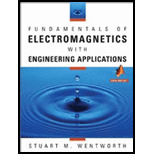
Concept explainers
Starting with Maxwell’s equations for simple, charge free media, derive the Helmholtz equation for H.
The Helmholtz equation for magnetic field
Answer to Problem 5.1P
The Helmholtz equation for magnetic field
Explanation of Solution
Given:
The Maxwell’s equations are simple and the media is free of any charge.
Concept used:
The equation of Ampere’s circuital law for simple and charge free media is shown below.
The equation of Faraday’s law is shown below.
Calculation:
The condition for charge free media is
Take curl on both sides of equation (1) as shown below.
Since, the right side of above equation is a position derivative that acts on time derivative, so the above equation can be written as,
Substitute
The curl of curl of any vector is equal to the divergence and Laplacian, so the above equation can be written as,
Due to charge free medium the value of divergence of magnetic field
Now, the above equation can be written as,
The above equation is known as Helmholtz wave equation for magnetic field
Therefore, the Helmholtz equation is
Conclusion:
Thus, the Helmholtz equation for magnetic field
Want to see more full solutions like this?
Chapter 5 Solutions
Fundamentals of Electromagnetics with Engineering Applications
- 3) A hypothetical metal that exhibits ferromagnetic behavior and has (i) a face centered cubic crystal structure (FCC), (ii) an atomic radius of 0.125 nm and (iii) has a saturation flux density of 0.58 Tesla. Determine the number of Bohr Magnetons per atom for this material.arrow_forwardQ5: What is the values of (P.d)min & ( Vbr)min for a gas dielectric with constants A=14, B=362 and Y=0.04/torr.cmarrow_forwardIn the Chapman-Enksog predictive model of conductivity of gases, increasing the temperature from 300 K to 400 K will increase the conductivity by the 2k to be independent of temperature. Why? A) 15.4 B) 33.3 C) 86.6 %. Assume thatarrow_forward
- 3. At room temperature the electrical conductivity of some semiconducting material is 29 (N-m)', whereas the clectron and hole mobilities are 0.05 and 0.02 m²/V-s, respectively. Compute the intrinsic carrier concentration for this material.arrow_forwardH.W: Find the potential at ra35m with respect to rB=15m due to a point charge Q=500pc at the origin and zero reference at infinity?arrow_forward6.8 A hollow conducting hemisphere of radius a is buried with its flat face lying flush with the earth's surface, thereby serving as an earthing electrode. If the conductivity of earth is o, show that the leakage conductance between the electrode and earth is 2nao.arrow_forward
- 1 - For a very long conducting channel viewed sectionally in the figure below, find the potentials at the indicated points. Use the symmetry to reduce the number of unknowns. 100V OV 100V OVarrow_forwardGiven up = 470 cm²/V-s for Si, what is the hole drift velocity at & = 10³ V/cm? What is Tmp and what is the average distance traveled between collisions, i.e., the mean free path?arrow_forwardApply the single charge particle model to “Non-uniform E field” case. Interchange the direction of B and E. Obtain the new drift, its magnitude, determine its direction; explain its result as well. This question is of plasma theoryarrow_forward
- Examples given in class such as BaTiO3 and Pb (Zr, Ti)O3 (PZT) show enhanced dielectric properties at their transition temperatures. Why is that? What happens in the structure to enhance the polarizability in this temperature region, explain?arrow_forwardA rectangular cross-section conductor has length/cross-sectional area ratio of 700 x 106 m-1, A current of 5 mA produces a voltage drop of 100 mV across the length. Determine the electron concentration given that the electron mobility is 500 cm²/Vs.arrow_forwardDescribe and explain the use of Maxwell Bridge and Hay Bridge for Inductor measurement. What considerations are the reasons for choosing the use of each bridge?arrow_forward
 Introductory Circuit Analysis (13th Edition)Electrical EngineeringISBN:9780133923605Author:Robert L. BoylestadPublisher:PEARSON
Introductory Circuit Analysis (13th Edition)Electrical EngineeringISBN:9780133923605Author:Robert L. BoylestadPublisher:PEARSON Delmar's Standard Textbook Of ElectricityElectrical EngineeringISBN:9781337900348Author:Stephen L. HermanPublisher:Cengage Learning
Delmar's Standard Textbook Of ElectricityElectrical EngineeringISBN:9781337900348Author:Stephen L. HermanPublisher:Cengage Learning Programmable Logic ControllersElectrical EngineeringISBN:9780073373843Author:Frank D. PetruzellaPublisher:McGraw-Hill Education
Programmable Logic ControllersElectrical EngineeringISBN:9780073373843Author:Frank D. PetruzellaPublisher:McGraw-Hill Education Fundamentals of Electric CircuitsElectrical EngineeringISBN:9780078028229Author:Charles K Alexander, Matthew SadikuPublisher:McGraw-Hill Education
Fundamentals of Electric CircuitsElectrical EngineeringISBN:9780078028229Author:Charles K Alexander, Matthew SadikuPublisher:McGraw-Hill Education Electric Circuits. (11th Edition)Electrical EngineeringISBN:9780134746968Author:James W. Nilsson, Susan RiedelPublisher:PEARSON
Electric Circuits. (11th Edition)Electrical EngineeringISBN:9780134746968Author:James W. Nilsson, Susan RiedelPublisher:PEARSON Engineering ElectromagneticsElectrical EngineeringISBN:9780078028151Author:Hayt, William H. (william Hart), Jr, BUCK, John A.Publisher:Mcgraw-hill Education,
Engineering ElectromagneticsElectrical EngineeringISBN:9780078028151Author:Hayt, William H. (william Hart), Jr, BUCK, John A.Publisher:Mcgraw-hill Education,





